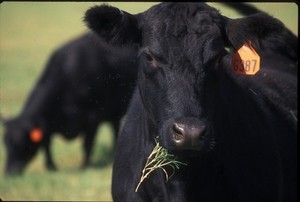FAO advises calm reaction to recent BSE scares
stay calm, after a few cases of mad cow disease are identified in
Canada and the US, and last month the first case of Bovine
Spongiform Encephalopathy (BSE) in a goat.
But the Food and Agriculture Organisation (FAO) cautioned this week that there is still a need for a 'steady, scientific approach' to ensure that the disease is kept out of unaffected countries.
"These cases were detected because of the testing procedures that are now in place," said Andrew Speedy, an FAO animal production expert.
More than 176 000 tests out of a total cattle population of almost 95 million have been carried out in the USA, and more than 21 000 out of 14.5 million cattle in Canada during 2004.
BSE belongs to the group of diseases that also include the brain-wasting disease of Creutzfeldt-Jakob Disease (CJD) in man and scrapie in sheep and goats. These diseases lead to a degeneration of brain tissue which takes on a typical spongy appearance.
Scientists believe that BSE causes variant Creutzfeldt-Jakob Disease (vCJD) in humans, by consumption of contaminated beef products from infected cattle. The particular variant form of the human disease has caused 148 deaths in the last 10 years, almost all in the UK. The recent case in Japan was a person who had visited the UK.
First identified in 1986 in the UK, 180,000 cases of BSE have since been diagnosed there alone and only four out of the 25 EU member states have not yet declared any cases. BSE has affected the entire beef food chain, from producer to consumer.
A recent report from the European Association of Animal Production estimates the cost of BSE to EU15 (prior to accession) member states at more than €90 billion. In addition, the BSE crisis has had a significant impact on public trust in government and governmental scientific advice.
The FAO said there is a need for a steady, scientific approach to ensure that the disease is kept out of unaffected countries.
"There is still some lack of understanding about BSE and how it can be detected and controlled," Speedy said. BSE can only be identified in adult animals; the animals that must be tested are cows that are casualties and fallen stock.
The Rome based group appears to be taking its lead for prevention from Switzerland, that had its first case of BSE in 1990 and peaked at 68 cases in 1995. There were just three cases in 2004.
The FAO is working with Swiss experts to train veterinary staff in other countries, including Asia, Eastern Europe, Latin America and the Near East, in methods of diagnosis, surveillance and prevention.
"Switzerland has a fool-proof system of cattle identification and registration, a scientific testing programme, preventative measures in the rendering and animal feed industry and complete support throughout the food chain," said the FAO.
BSE is a fatal disease of adult cattle characterised by degeneration of the central nervous system. The causative agent is thought to an abnormal form of a protein called a 'prion'. The transmission of BSE is thought to be by the oral ingestion of animal feed containing BSE-infected meat and bone meal.
The goat diagnosed with BSE in France was the first food animal other than cattle to contract the disease naturally.
Previously, scientists believed that sheep and goats were only affected by scrapie which is distinguishable from BSE and not thought to be transmissible to humans.
But FAO stressed that this is one example in millions, and the goat was born before Europe imposed a total ban on feeding of MBM (meat and bone meal) to livestock in January 2001.





